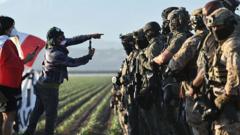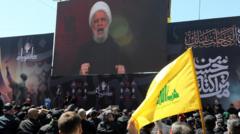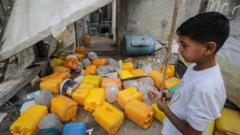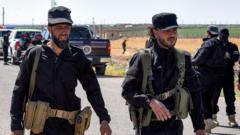A recently established aid distribution system in Gaza, backed by the US and Israel, has resulted in chaos and bloodshed. With reports indicating more than 500 deaths linked to aid-seekers caught in gunfire, the situation remains dire as international agencies struggle to navigate dangerous conditions while delivering vital assistance.
Chaos Erupts as Gunfire Disrupts Gaza's New Aid Distribution System

Chaos Erupts as Gunfire Disrupts Gaza's New Aid Distribution System
As aid distribution in Gaza faces tragic incidents of violence and confusion, over 500 lives have been claimed amidst a precarious humanitarian effort.
A month into a contentious aid distribution system in Gaza, the landscape has been marred by gunfire and turmoil as individuals attempt to collect essential aid. Analysis from BBC Verify of multiple video reports reveals alarming trends, including gunfire erupting near aid-seekers and the presence of injured or deceased Palestinians. The Hamas-run Gaza health ministry asserts that over 500 individuals have been killed and around 4,000 injured, attributing the vast majority of these incidents to Israeli fire according to medics and eyewitness accounts.
While BBC Verify aims to ascertain the source of the violence, the prevailing narrative underscores a climate of confusion and peril. In the intervening month, the Israel Defense Forces (IDF) have maintained that they have issued "warning shots" directed at those they classify as "suspects," arguing that Hamas hampers the success of aid distribution and jeopardizes the welfare of Gaza's residents.
Following an easing of a blockade on aid on May 18, the IDF established four aid distribution points—operating under the Gaza Humanitarian Foundation (GHF)—in various locations across the region. The US State Department has reported contributing $30 million to the GHF, the inaugural financial support for this organization since its formation.
From the outset, the United Nations condemned the initiative, citing concerns that it would "militarize" humanitarian aid, bypass existing networks, and compel individuals to traverse perilous terrains to obtain food. Less than a week after the system commenced, several tragic incidents resulted in numerous fatalities, prompting international outcry.
Although the IDF claims ongoing assessments to enhance operational responses, criticism persists from global observers regarding the frequency of fatalities linked to aid collections. Reports from the Red Cross indicate its field hospital has activated mass casualty protocols multiple times, highlighting gunshot wounds afflicting individuals en route to aid sites.
The situation escalated dramatically on June 9, with video footage capturing people frantically fleeing gunfire while attempting to obtain aid. By June 10, the number of causalities reported had climbed into the thirties. With chaos reigning over aid distribution endeavors, the GHF has indicated efforts to manage designated "safe passages," while cautions about the dangers of venturing into restricted areas are communicated through modern channels.
Tragedy continued with verified footage showing the aftermath of a sudden attack that left over 21 deceased individuals in the vicinity of an aid distribution truck, a situation the IDF has since acknowledged. Amidst the deteriorating humanitarian conditions, the GHF reports having distributed millions of meals to beneficiaries, citing their commitment to scale operations despite the mounting challenges.
As the environment remains perilous for aid-seekers, both the UN and humanitarian organizations emphasize the necessity for enhanced aid availability to mitigate tension and urgency within the local population, demanding urgent action amid proliferating crises.



















